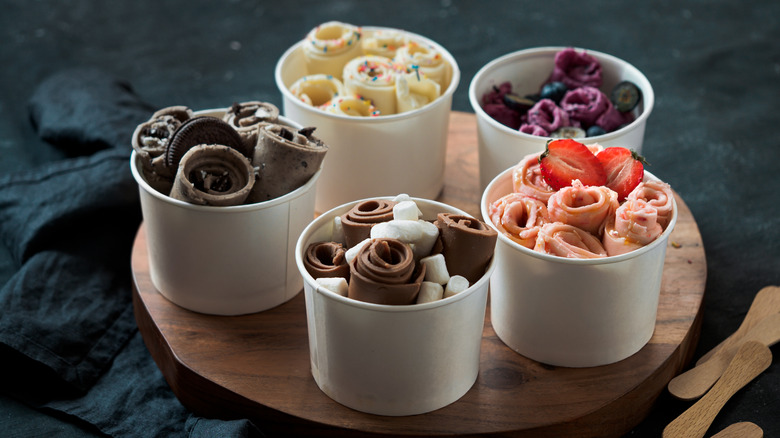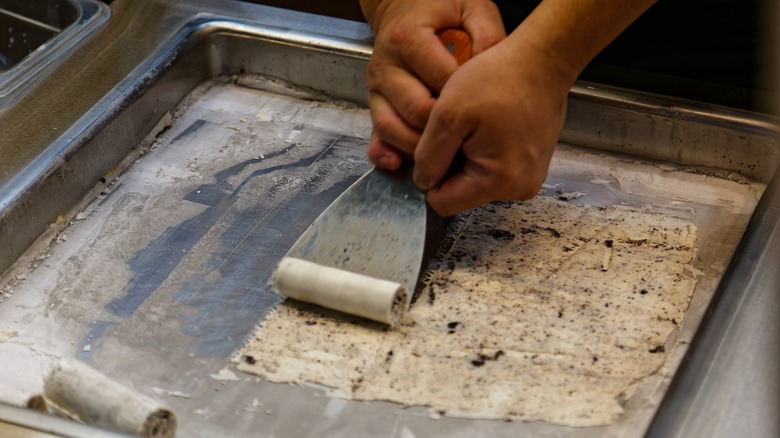The Thai Origins Of Rolled Ice Cream And How It Became A Beloved Treat Around The World
In marked contrast to some of southeast Asia's most iconic frozen desserts — confections like Singapore's ais kacang and the Philippines' halo-halo — ai tim phad is a relative newcomer to the world of icy confections rooted in Asia's culinary traditions. Better known in the United States as rolled or stir-fried ice cream, ai tim phad debuted on the world stage sometime around 2009. That's when social media-connected patrons of Thailand's street markets began sharing video and images of the mesmerizing — and highly Instagrammable — process of making the frozen treat. It's still not clear exactly who came up with the idea, what inspired them to experiment with rolling ice cream, or even when and where it was introduced, but as one post after another went viral, the ice cream confection quickly rocketed to the realm of social media stardom.
Although social media made Thai-style rolled ice cream world famous, the coveted treat wasn't initially widely available beyond Thailand. That began to change as entrepreneurial social media fans, inspired by videos showcasing what appeared to be a fairly simple process, decided to take matters into their own hands. Those fans included three New York City-based fraternity brothers who ultimately opened their own ice cream roll-centric business, 10Below, to rave reviews. Almost immediately, patrons were standing in line for up to an hour at the Chinatown ice cream emporium. A long wait for sure, but nowhere near as long and expensive as a flight to Thailand.
Rolling puts a new spin on an old favorite
We can't say for sure if 10Below was the first venture of its kind in the U.S., but we do know it was one of the firsts in New York City — and its opening spawned a media frenzy garnering coverage on the Food Network and in publications like Forbes and Cosmopolitan. Which is interesting because the coveted ice cream confection isn't even all that original. It's basically ice cream with mix-ins — think Cold Stone Creamery. The brand that built its name on chopping and mixing fruit, candy, and nuts into ice cream has been around since 1988. Which brings us back to our lingering who, when, where, and why questions about the genesis of Thai-style ice cream rolls.
Daniel Gray, a food-marketing consultant in Seoul, has a theory. In 2017, Gray told The New York Times that in Asia, the texture of food is as important as taste. "You would never be served plain ice cream in a cup here," he said. "That would be too boring." Another important element? Presentation. Cuteness really counts. Factor in a bit of friendly competition among Asia's street food vendors to come up with the next and newest best thing, and you have an environment ripe for innovation. So, while ice cream with mix-ins may not be a groundbreaking concept, the rolled style of Thai ice cream rolls — they a look like a bouquet of rose buds in a cup — puts the confection in a whole new light.
Here's how the magic happens
The process starts with a classic crème anglaise, a silky and sweet combination of cream, sugar, and egg yolks. The custardy cream sauce is a key ingredient in all kinds of pastries and desserts. Sometimes called the dessert world's "mother of all sauces," — a reference to the five mother sauces that form the foundation of French cooking — crème anglaise is basic, but adaptable. Blend in cornstarch, bring it to a boil, and you have pastry cream. Bake it and you have pot de crème. Sprinkle the baked custard with sugar and use a torch to caramelize it. Sound familiar? Crème brȗlée! Freeze it and, you guessed it, you have a rich ice cream that, when done right, becomes the basis for Thai-style ice cream rolls.
In a street market or ice cream parlor, the vendor probably has special equipment like a liquid nitrogen-cooled stainless-steel pan. That's important because the magic has to happen on an ultra-cold (-15 °C or about 5 °F) surface. That doesn't mean you can't try this at home. You can blend the ingredients and freeze overnight before rolling. It's just not as dramatic. Pour a thin layer of crème anglaise onto the cold work surface. As soon as it freezes, begin working the mixture. Using two metal spatulas, chop, flatten, and spread the cream while adding flavoring and mix-ins. When the mixture is smooth, spread into a thin layer, then use a spatula to scrape and roll individual strips.


